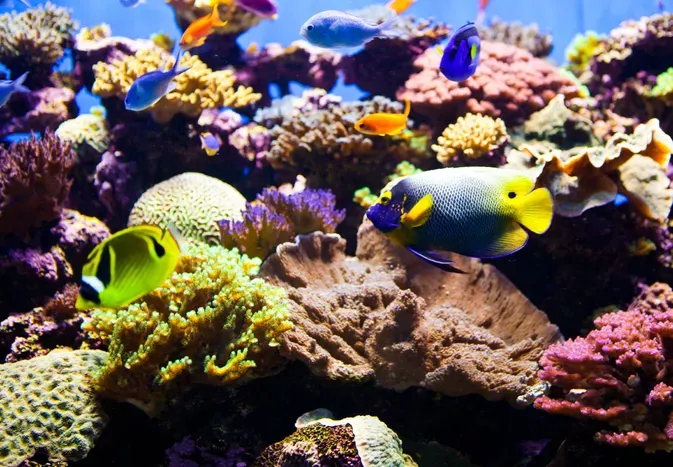Using Powerheads For Water Circulation In Saltwater Aquariums
Updated on 04/26/24

Harnessing the Power: A Comprehensive Guide to Using Powerheads for Water Circulation in Saltwater Aquariums
In the realm of marine aquariums, maintaining optimal water quality is paramount for the health and well-being of its inhabitants. Powerheads, indispensable tools in this endeavor, play a crucial role in ensuring proper water circulation, aeration, and nutrient distribution. This comprehensive guide will delve into the intricate world of powerheads, empowering you with the knowledge and techniques to harness their power effectively.
Understanding the Significance of Water Circulation
Water circulation is the lifeblood of a saltwater aquarium, serving several critical functions:
* Gas exchange: Powerheads facilitate the exchange of gases between the water and the atmosphere, ensuring adequate oxygen levels for aerobic organisms and removing waste gases like carbon dioxide.
* Nutrient distribution: They promote the even distribution of nutrients throughout the aquarium, preventing nutrient buildup in certain areas and ensuring its availability to all organisms.
* Waste removal: Powerheads help remove waste and debris from the water column, maintaining water clarity and preventing harmful accumulation.
* Preventing stagnation: By creating water movement, powerheads prevent water stagnation, which can lead to anaerobic conditions and the proliferation of harmful bacteria.
Types of Powerheads
Powerheads come in various types, each suited to specific aquarium needs:
* Submersible: Designed to be completely submerged in the water, submersible powerheads offer the most versatility and can be placed anywhere in the aquarium.
* External: These powerheads are mounted outside the aquarium, connected to a submerged pump. They provide more power and can handle larger volumes of water.
* Hang-on: Hang-on powerheads attach to the rim of the aquarium and direct water flow inward. They are ideal for shallow tanks or aquariums with limited space.
Choosing the Right Powerhead
Selecting the appropriate powerhead for your aquarium requires careful consideration:
* Tank size: Powerheads should be rated for the volume of water in your aquarium. A general rule of thumb is to provide a turnover rate of at least 10 times the tank volume per hour.
* Flow rate: The flow rate of a powerhead determines the amount of water it moves. Choose a powerhead that provides sufficient flow without creating excessive turbulence.
* Head height: This refers to the height that a powerhead can pump water. It is particularly important for external powerheads that need to overcome the height of the aquarium.
Placement and Orientation
The placement and orientation of powerheads are crucial for optimal water circulation:
* Strategic placement: Place powerheads in areas with low flow, such as behind rocks or in corners.
* Angled flow: Direct the flow of powerheads at an angle to create a swirling motion, maximizing water circulation.
* Multiple powerheads: Use multiple powerheads to create a more uniform flow pattern throughout the aquarium.
Examples of Powerhead Applications
To illustrate the effectiveness of powerheads, here are some specific examples of their applications:
* Creating currents: Powerheads can simulate natural currents, providing a more dynamic and stimulating environment for marine life.
* Enhancing filtration: Powerheads can be used to improve the efficiency of filtration systems by directing water flow through filter media.
* Targeted feeding: Powerheads can be used to direct food to specific areas of the aquarium, ensuring that all organisms have access to nourishment.
Maintenance and Troubleshooting
Regular maintenance is essential to ensure the optimal performance of powerheads:
* Cleaning: Clean powerheads regularly to remove algae, debris, and other contaminants that can reduce flow.
* Impeller inspection: Inspect the impeller periodically for wear or damage. Replace the impeller if necessary.
* Lubrication: Lubricate the powerhead's shaft regularly according to manufacturer's instructions.
Troubleshooting common powerhead problems:
* Reduced flow: Check for blockages in the powerhead or intake tube. Clean the powerhead and remove any obstructions.
* Noise: Noise can indicate a worn impeller or a misaligned shaft. Inspect the powerhead and replace or adjust as needed.
* Leaking: Check the powerhead's seals for cracks or damage. Replace the seals if necessary.
Conclusion
Powerheads are indispensable tools for maintaining a thriving saltwater aquarium. By understanding their significance, selecting the appropriate type, and positioning them strategically, you can harness their power to create an environment that promotes the health and vitality of your marine inhabitants. Remember to perform regular maintenance and troubleshoot any issues promptly to ensure optimal performance. Embrace the transformative power of powerheads and elevate your saltwater aquarium to new heights of beauty and well-being.
Explore More Pets

Freshwater Aquarium Filters
How to Deal With Cloudy Aquarium Water

Saltwater Aquarium Filters
How Do You Remove Chloramines From Tap Water?

Freshwater Aquariums & Habitat
Can I Keep My Koi Fish Inside?

Saltwater Aquariums & Habitat
14 Best Floating Plants for Your Aquarium

Freshwater Fish Health
How to Treat Ich on Freshwater Fish

Saltwater Fish Health
Fin Rot in Aquarium Fish

Freshwater Aquarium Filters
How to Do Aquarium Water Changes

Saltwater Fish Health
How Do Fish Get Parasites?